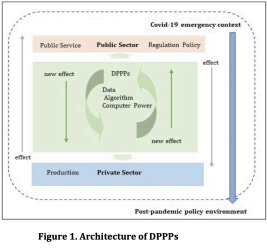Finalizing the Path to an Efficient Public Sector: The Double Coincidence of Wants
By Saran Mariya Erdenetuul, GRC 2024 Global Essay Competition Top 30
“... staffing shortages have cost hospitals $24 billion over the course of the pandemic.”1 The inefficiencies of the public sector are evident in the eyes of society; however, the costs incurred also impact government budgets. Economies across the globe have sought and implemented distinct measures, such as profit incentives, increased transparency, etc.2 Nevertheless, a solution emerges that encompasses all these efforts and addresses the urgency of the matter: public-private partnerships (PPPs).
As defined by the World Bank, a public-private partnership is “a long-term contract between a private party and a government entity, for providing a public asset or service.”3 The private partner assumes the role of co-funding and implementing projects for which they have developed productive proposals. To offset the significant risks they undertake, the government provides incentives- a crucial duty alongside other responsibilities such as monitoring and ensuring compliance with laws.4 For the welfare of society, these partnerships offer innovative alternatives to public sector goods and services, complemented by private sector expertise and resources, without jeopardizing sustainability or the state of the government budget.
In 2002, it was noted that the U.S Department of Defense accounted for 57% of Lockheed Martin Corporation’s sales and the U.S government for 78% of Northrop Grumman, the single source of the Navy’s aircraft carriers.5 The Boeing Company’s U.S government contracts, entailing the production of military aircraft, systems, and training, represented 37% of the corporation’s revenue in 2023. These three companies dominate the worldwide defense industry whereas the U.S remains the strongest military power in the world; however, this comes at a cost of $842 billion.6 Public-private partnerships in this sector are immensely useful: research and development costs are covered, efficient production and a stable supply chain are procured for the government in turn for incentives, such as tax credits, government grants, and set profits by fixed-price contracts7- no costs outweigh the savings generated.
On the other hand, in low-to-middle-income countries, challenges arise due to inefficient government structures. Long-term solutions emerge when the public sector accords with a private party; however, such measures will not be effective if root problems remain unaddressed. The solution lies in the technology, digital frameworks, and efficiency offered by small businesses. Investment in such allows a strong foundation for the public sector that is necessary to establish effectiveness, and to solve issues that are deemed systemic. In 2001, in partnership with private technology providers from Latin America and Europe, electronic means of communication were introduced into political processes in Ipatinga, Brazil, “to incentivize citizen participation with the goal of revitalizing democracy.”8 The initiative permits the public to vote on political responsibilities that are of the highest priority, so budget allocation is efficient, satisfying the most needs. Additionally, individuals are prompted to participate in face-to-face meetings, allowing segments of the population, specifically marginalized groups, to be dutifully represented.
Public-private partnerships provide a flexible framework tailored to the government at hand, their state of development, and the areas that the people consider most concerning. Anyhow, we shall review a case of a matter that has affected the whole world and, even now, one we have not fully recovered from: the COVID-19 pandemic. Digital Public-Private Partnerships (DPPPs), entailing cooperation between Digital Tech Giants and public organizations, addressed governments’ issue of “the lack of technological resources for more efficient and effective services”9 through capacity sharing and innovation, as seen in Figure 1. In the U.K., Google, Twitter and Facebook collaborated with the government to combat misinformation on platforms. In the U.S., IBM contributed to improving treatments for the virus in agreement with the White House. DPPPs are novel, and their potential has only been realized through the development of sophisticated technologies seen today; however, government responsibilities could be carried out at inconceivable rates, with greater returns and outputs, if there is better awareness of suitable opportunities.
Figure 1:
Public-private partnerships, as the power of technology has become increasingly prominent, offer long-term solutions to problems in the public sector that are considered systemic: a vulnerable government budget, lack of citizen participation, or inadequate resources. Moreover, partnerships are flexible in their use and are time- and cost-saving, as governments are not required to invest using their own capital; instead, private parties provide the necessary resources. Incentives must be offered by the public party, designed to avoid jeopardizing sustainability- such as tax credits and fixed-price contracts. This double coincidence of wants is a ready resort for governments to either secure the foundation of operations or improve the provision of public goods and services in a cost-effective way, all contributing to the efficient allocation of the economy’ s resources. Nations must utilize PPP contracts further; their benefits are comparable to those of international trade.
“Data Brief: Health Care Workforce Challenges Threaten Hospitals’ Ability to Care for Patients.” American Hospital Association, October 2021.
Kunicova, Jana. “The Five Drivers for Improving Public Sector Performance: Lessons from the New World Bank Global Report.” Web log. Blogs.Worldbank.Org (blog). World Bank, October 24, 2018. https://blogs.worldbank.org/en/governance/five-drivers-improving-public-sector-performance-lesson s-new-world-bank-global-report.
World Bank. “About Public-Private Partnerships.” PUBLIC-PRIVATE-PARTNERSHIP RESOURCE CENTER, October 10, 2024. https://ppp.worldbank.org/public-private-partnership/applicable-all-sectors/about-public-private-partnerships.
Team, The Investopedia. “Public-Private Partnerships (Ppps): Definition, How They Work, and Examples.” Investopedia, June 6, 2024. https://www.investopedia.com/terms/p/public-private-partnerships.asp#toc-how-public-private-partn erships-work.
University, Stanford. “Company Profiles.” The three largest defense companies in the world are, 2002. https://web.stanford.edu/class/e297a/U.S.%20Defense%20Industry%20and%20Arms%20Sales.ht m.
.org, USAFacts. “How Much Does the US Spend on the Military?” USAFacts.org, August 1, 2024. https://usafacts.org/articles/how-much-does-the-us-spend-on-the-military/.
Office, U.S. Government Accountability. “Fixed-Price-Incentive Contracts: DOD Has Increased Their Use but Should Assess Contributions to Outcomes.” Fixed-Price-Incentive Contracts: DOD Has Increased Their Use but Should Assess Contributions to Outcomes | U.S. GAO, February 3, 2021. https://www.gao.gov/products/gao-21-181.
Gakhal, Jaskiran, ed. “The E-AGORA Project: Participatory Budgeting in Ipatinga, Brazil.” Participedia.net, August 23, 2020. https://participedia.net/case/2369.
Wu, Sheng. Rep. Innovative Digital Public-Private Partnerships from Pandemic Response to Resilient Recovery: Linking Emerging Frontier Technologies with Sustainable Development. UN, n.d.



